Magma source and tectonic setting of the Dunde granite in the Western Tianshan: constraints from geochronology,geochemistry,and Sr–Nd–Hf isotopes
Zhaode Xia • Haibo Ding • Yanjiao Ru
Abstract The Dunde iron-zinc polymetallic deposit is one of large iron deposits occurred in the Awulale Metallogenetic Belt,Western Tianshan (NW-China).This study reports new geochronology and geochemistry for granite in the Dunde mining area in order to constrain the tectonicmagmatic activities and metallogenesis of this region.Granites in the southwest of Dunde mining area are mainly syenogranites intruded into volcanics of the Dahalajunshan Formation in the Early Carboniferous,and they are far from the area where ore bodies and mineralized altered rocks are widely developed.LA-ICP-MS U–Pb zircon dating indicates that Dunde syenogranite was at 306.8 ± 1.0 Ma,which could constrain the upper limit of metallogenic age for this deposit.The Dunde granites are high SiO2 (73.41–80.07 wt%),high differentiation index(D.I.=89.7–95.0),weakly peraluminous to metaluminous(A/CNK=0.94–1.08),and they are enriched in LILE and LREE and depleted in Eu,Ba,Sr and P2O5,indicating that they belong to highly fractionated I-type granite.Based on εHf values (+9.2 to+10.5) for zircon and high εNd(-t) values (+4.7 to+5.8) for whole-rock,and the twostage model ages for 601–735 Ma,suggest that the magma source could be the juvenile lower crust.Combined with regional geological setting,the 306.8 Ma Dunde granites are formed in post-collision extensional tectonic setting.
Keywords Granite ∙Geochemistry ∙Magma source ∙Tectonic setting ∙Dunde deposit ∙Western Tianshan
1 Introduction
Granite is an important part of continental crust and a window to understanding the orogenic process and crustal evolution (Amit et al.2003;Peccerillo et al.2004).At the same time,acidic magmatic activity can provide heat and metal elements for the formation of ore deposits,which is of great significance for mineralization.
The Awulale Metallogenic Belt (AMB) in the Western Tianshan,a part of the Central Asian Orogenic Belt(CAOB) (Xiao et al.2004;Gao et al.1998;Wang et al.2008;Qian et al.2009),contains many billion tons iron ore deposits (Wang et al.2019).These deposits occur mainly in the volcanics of Dahalajunshan Formation.Based on geochronology of volcanics from these deposits,the epoch of mineralization in the AMB is mainly in Early Carboniferous at ca.330–316 Ma(Feng et al.2010;Jiang et al.2014;Zhang et al.2012) and Late Carboniferous at ca.310–305 Ma(Jiang et al.2012).The tectonic setting of the ore-hosting volcanic rocks is disputed between continental rift(Che et al.1996;Xia et al.2004)and continental arc setting (Gao et al.1998,2009;Wang et al.2007;Zhu et al.2009;Jiang et al.2012,2014;Zhang et al.2012).There are different metallogenesis models for these deposits in the AMB,such as VMS deposits,skarn deposits,magmatic and hydrothermal polygenetic deposits,and hydrothermal deposit models (Zhao et al.2006;Feng et al.2010;Wang et al.2011,2019;Hong et al.2012;Jiang et al.2014;Duan et al.2014;Ge et al.2014;Yan et al.2020;Li et al.2020).Different from other deposits,the Dunde deposit is the unique large iron deposit with symbiotic zinc and associated gold in the AMB.Although the Dunde deposit has been extensively studied in terms of petrology,geochemistry,chronology,and mineralization(Duan et al.2014;Jing 2016;Ding 2017;Ge et al.2014;Yan et al.2018,2020;Li et al.2020),the tectonic setting and mineralization are still controversially.It’s still debatable whether this deposit belongs to skarn-type deposits,and the study of intrusive rocks in the mining area is helpful to better understand the problem.Furthermore,the study of intrusive rocks in this Dunde iron deposit area is relatively weak,so the nature of the source area deserves further study.In this study,we present geochronology,geochemistry,and Nd-Hf isotopic data from the granite in the Dunde mining area of the AMB.We further intend to constrain the genesis of the granite through comprehensive research and define the formation of the Dunde deposit.
2 Geological setting
There are many important large-scale iron ore deposits in the AMB (Fig.1) such as Beizhan,Dunde,Zhibo,Chagangnuoer,Songhu and other deposits.In these mining areas,the strata are mainly Silurian to Jurassic rocks (Gao et al.1998;Li et al.2009;Feng et al.2010;Hu et al.2000;Li et al.2009;Wang et al.2014a,b).The Silurian strata consist of flysch,carbonate and volcanic formation.The Upper Devonian is a set of littoral—marine alternating volcanic-normal clastic rock and carbonate formation,while the Middle Devonian is a set of shallow marine volcanic-clastic rock with a small amount of normal clastic rock.The Carboniferous strata is the most widely distributed strata in this area.The Dahalajunshan formation of Lower Carboniferous is composed of marine volcanic eruption-sedimentary clastic rocks intercalated with carbonate rocks.The first subgroup of the Dahalajunshan formation consist of gray-green dacite tuffaceous breccia,andesitic crystalline tuff,tuffaceous conglomerate,limestone,andesite,diabase porphyrite.The second sub-group of the Dahalajunshan formation is gray to grey-green rhyolite fused tuff,white and gray giant thickness bedded crystalline limestone,and crystal-lithic tuff.The third subgroup is mainly gray-green andesitic crystal clastic vitric tuff intercalated with diorite porphyrite and andesitic porphyrite.The Yishjilik Formation of Upper Carboniferous is mainly a set of volcanic breccia,tuff and lava,partially interlaced with normal sedimentary rocks and limestones,and has a flysk-like formation with continental and marine interaction.Permian is a yellowish-gray—gray normal terrigenous clastic molasse formation (Feng et al.2010;Allen et al.1992).
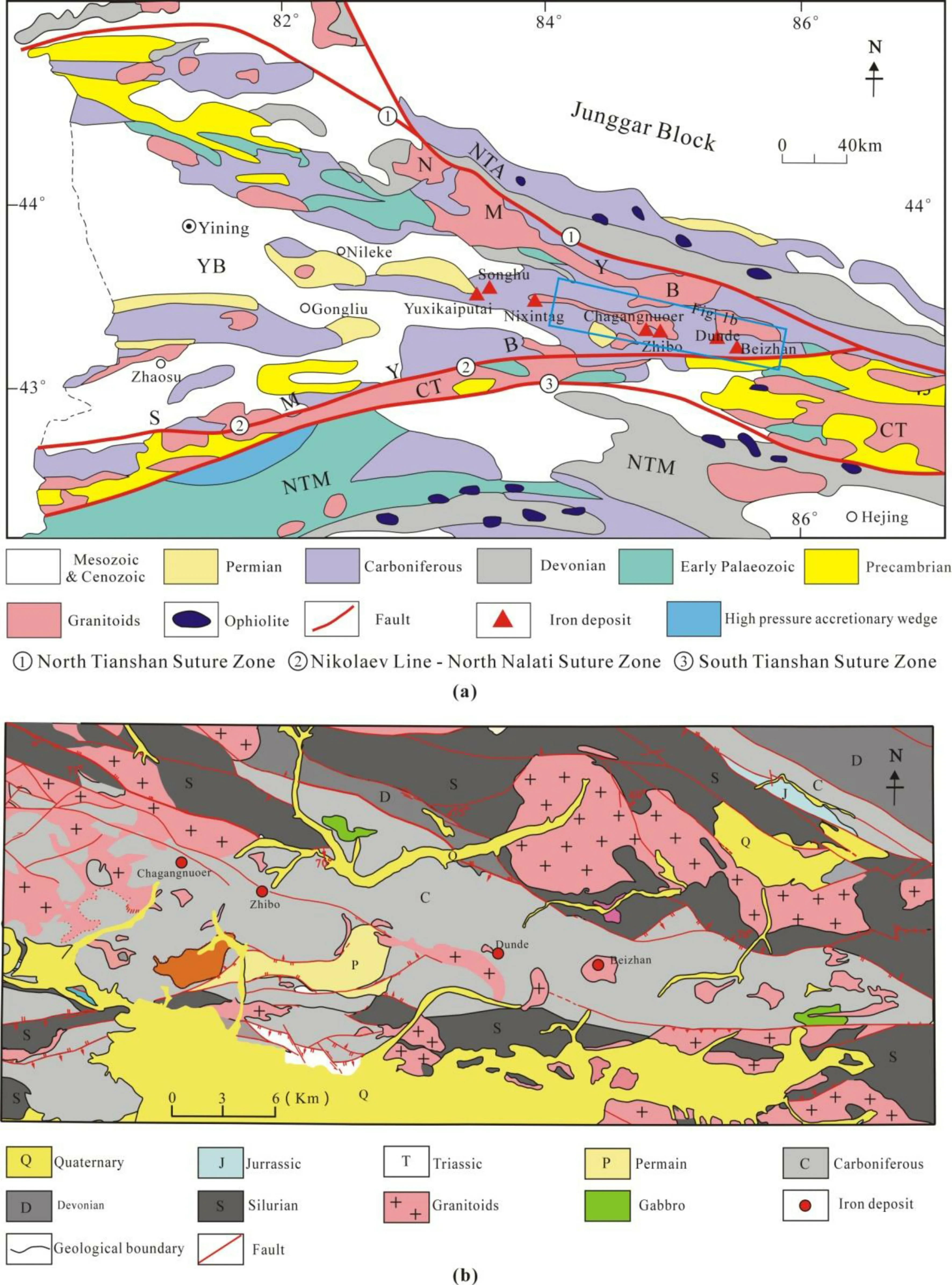
Fig.1 a Simplified geological map of West Tianshan Mountains (modified after Gao et al.2009).b Geological map of the Chagangnuoer–Beizhan Iron deposits (modified after Wang et al.2019)
The Dunde deposit is controlled by volcanic mechanisms and occurs in the volcanics of Dahalajunshan Formation.The host rocks are mainly basaltic tuff,dacitic crystalline tuff,dacite and andesite (Fig.2).A total of 45 iron-zinc and zinc ore bodies have been delineated in the latest exploration results,the main Fe I ore body is estimated to contain 139Mt iron,1.29Mt zinc and 28.91 tons of associated gold (Ding et al.2017).The intrusive rocks exposed in the Dunde mining area mainly are granite and diorite.The zircon U–Pb ages for these in the deposits are as follows: 295.8 Ma and 305.3 Ma for syenogranite and 301 Ma for diabase dykes (Duan et al.2014;Kang 2018).
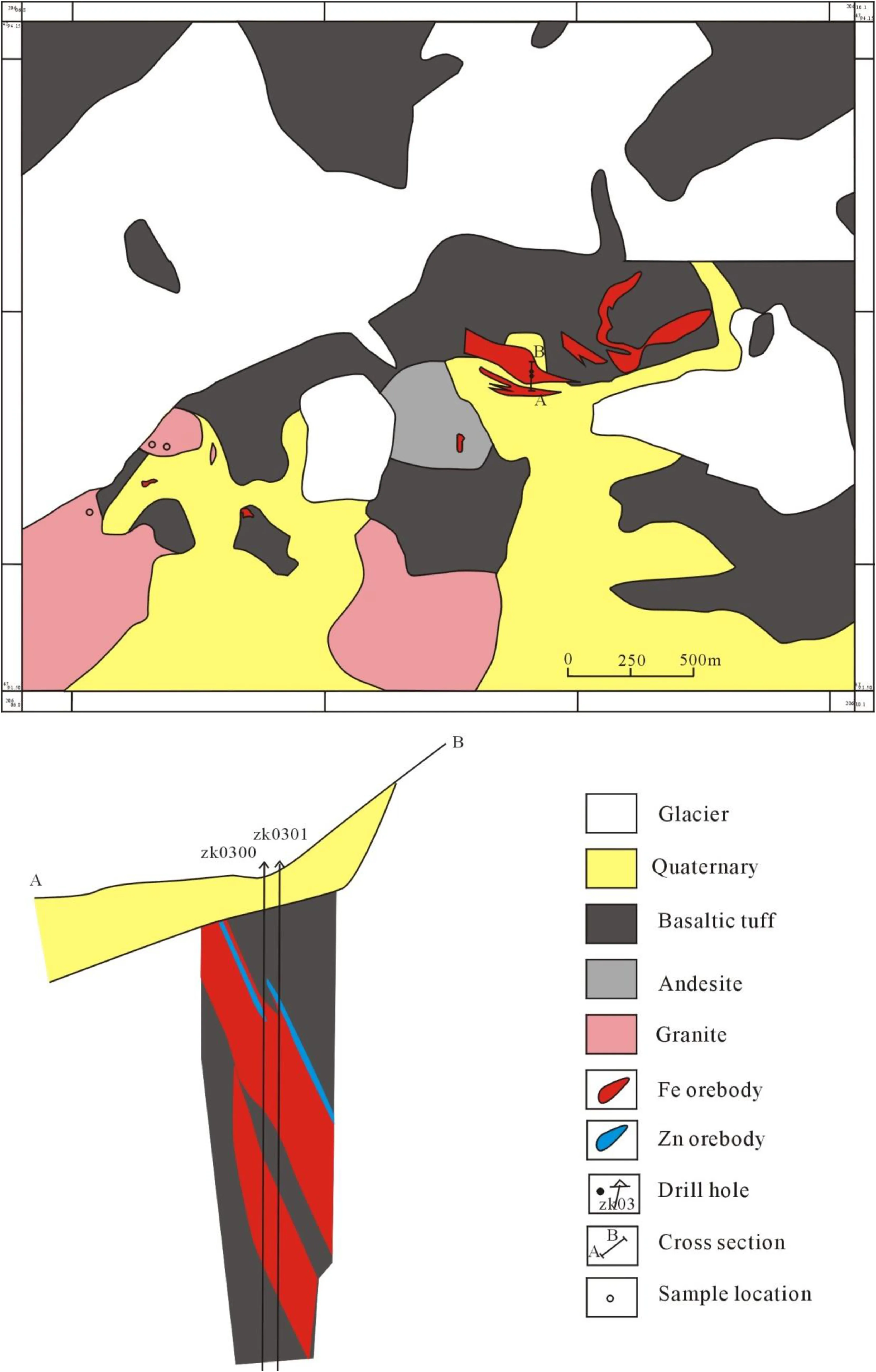
Fig.2 Simplified geological map of the Dunde Iron deposits (modified after Duan et al.2014;Jing 2016)
3 Petrography of granite intrusions
Abundant granite intrusions mainly distributed in the southwest of the Dunde deposits and intruded the volcanics of the Dahalajunshan Formation,Early Carboniferous(Figs.2,3a).They are not contacted with limestone and far from the area where ore bodies and mineralized altered rocks are widely developed (Fig.2).The main rock types of granite are syenogranite,fleshy red,medium—coarse granular texture and graphic texture (Fig.3b).The rocks mainly consist of orthoclase(55–60 %),quartz(30–40 %),plagioclase (5–10 %) and biotite (<5 %).Plagioclase is grayish white,self-shaped—semi-self-shaped plate columnar,2–6 mm and some grains have been altered to sericite (Fig.3f);Orthoclase is mainly semi-automorphic to other-shape and particle size of 2–6 mm,and most grains have been altered to kaolinite (Fig.3e).Quartz is packed in other shapes between the minerals,and some quartz and orthoclase symbiosis constitute graphic-like texture (Fig.3c–d).Biotite is distributed in self-shaped to semi-self-shaped columnar and lamellar forms,and most biotite grains have been altered to chlorite and magnetite(Fig.3e–f).
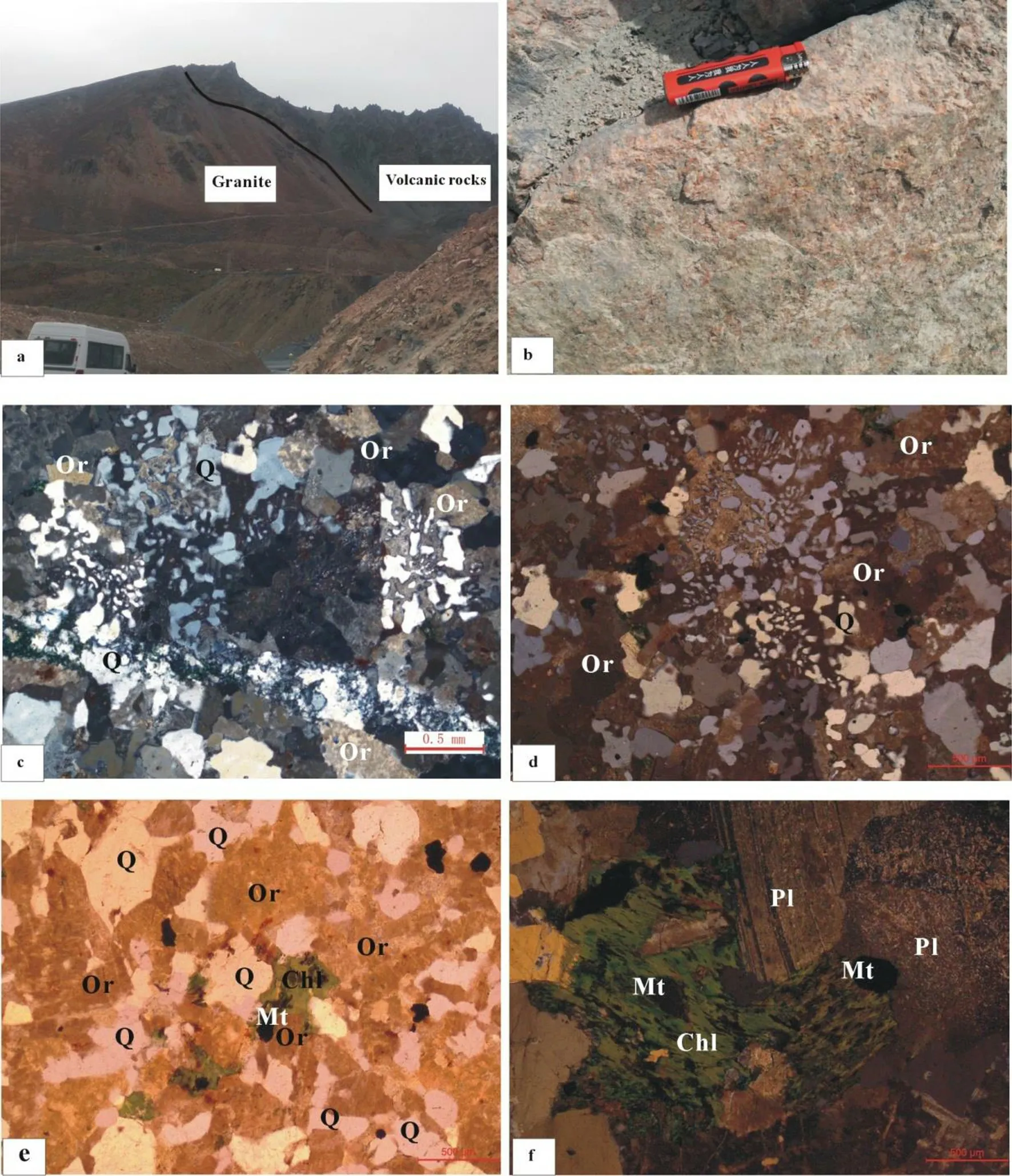
Fig.3 Field photos and representative photomicrographs for the Dunde granites in the Western Tianshan.a Granitoid intrusions intruded the volcanic host rocks of the iron mineralization in the Early Carboniferous Dahalajunshan Formation.b The Dunde granites mainly consist of quartz(Q)and orthoclase(Or).c,d.Quartz and orthoclase(Or)symbiosis constitute graphic-like texture.e Orthoclase is altered to kaolinite and biotite (Bi) is altered to chlorite and magnetite.f Plagioclase (Pl)is altered to sericite and biotite (Bi) is altered to chlorite (Chl) and magnetite(Mt)
4 Analytical methods
Zircon U–Pb dating and hafnium isotope were performed using the RESOlution LR 193 nm laser denudation system manufactured by Australian Scientific Instruments at LAMC-ICP-MS at Nanjing FocuMS Technology Co.Ltd.The 193 nm ArF excimer laser,homogenized by a set of beam delivery systems,was focused on zircon surface with a fluence of 3.5 J/cm2.The ablation protocol employed a spot diameter of 50 μm at an 8 Hz repetition rate for 40 s(equating to 320 pulses).Helium was applied as a carrier gas to efficiently transport aerosol to MC-ICP-MS.Standard zircons (including GJ-1,91500,Plesˇovice,Mud Tank,Penglai)were treated as quality control for every five unknown samples.The analytical procedures of the LAMC-ICP-MS analytical system for zircon U–Pb dating and hafnium isotope are described in detail by Jackson et al.(2004)and Geng et al.(2017),respectively,and the zircon U/Pb data and Hf isotope data are presented in Tables 1 and 2,respectively.
The whole-rock major oxides were measured by a PANalytical Axios mAX X-ray fluorescence (XRF) spectrometry,while the trace elements were analyzed with an Agilent Technologies 7700 × quadrupole ICPMS at Nanjing FocuMS Technology Co.Ltd.The analytical uncertainties for both major and trace elements (including the REE) are generally 1–5 %.The detailed analytical procedures are described by Li et al.(2006),and the analyzed elemental compositions are listed in Table 3.
Sr and Nd isotopic analyses were performed using a Nu Plasma II MC-ICP-MS at the Nanjing FocuMS Technology Co.Ltd.,following the analytical procedures in Li et al.(2006).Measured143Nd/144Nd and87Sr/86Sr ratios were normalized to146Nd/144Nd=0.7219 and86Sr/88Sr=0.1194,respectively.Isotopic results of geochemical reference materials BCR-2 (87Sr/86Sr=0.705017± 0. 000005;143Nd/144Nd=0.512649 ± 0.000003),STM-2(87Sr/86Sr=0.703704 ± 0. 000005;
143Nd/144Nd=0.512907 ± 0.000002),AVG-2 (143Nd/144-Nd=0.512795 ± 0.000002),GSR-10 (87Sr/86Sr=0.704369± 0. 000005;143Nd/144Nd=0.512762 ± 0.000003),GSR-15(87Sr/86Sr=0.719369 ± 0. 000005;
143Nd/144Nd=0.512897 ± 0.000003) and RGM-2 (87Sr/86-Sr=0.704170 ± 0. 000004;
143Nd/144Nd=0.512796 ± 0.000003) were within the recommended values(Weis et al.2006).The analytical results are given in Table 4.
5 Results
5.1 Geochronology
The zircon U–Pb data for the Dunde granite are in Table 1.Most zircon grains are black to gray with an obscure oscillatory texture in the CL images.These zircon grains are long prismatic morphology and are usually 70–160 μm in length with 30–80 μm in width.The Th/U ratios of zircon are 0.21–0.79 (Table 1),greater than 0.1,indicating these zircons crystallized from magma.All analyzed spots yield a weighted mean206Pb/238U age of 306.8 ± 1.0 Ma(Fig.4),indicating the crystallization age of the Dunde granite.

Table 1 Zircon LA-ICP-MS U–Pb isotopic data of sample H-1 from the Dunde granites

Fig.4 LA-ICP-MS U–Pb zircon concordia diagrams for granitoids associated with the Dunde iron deposits
5.2 Whole-rock geochemistry
All granites from the Dunde deposit area are high in SiO2(73.4–80.1 wt%) and alkalis (Na2O+K2-O=6.63–8.48 wt.%).They have low TiO2(0.13–0.27 wt%),Al2O3(10.29–13.35 wt%),Fe2O3T(0.59–1.88 wt%),MgO (0.10–0.22 wt%) and P2O5(0.01–0.04 wt%) (Table 2).In the K2O vs.SiO2diagram(Fig.5a),all samples of the Dunde granites plot in the fields of high K-calc-alkaline rocks.All samples have A/CNK [molar ratio of Al2O3/(CaO+Na2O+K2O)]varying from 0.94 to 1.08,and belong to weakly peraluminous to weakly metaluminous (Zen 1986) (Fig.5b).
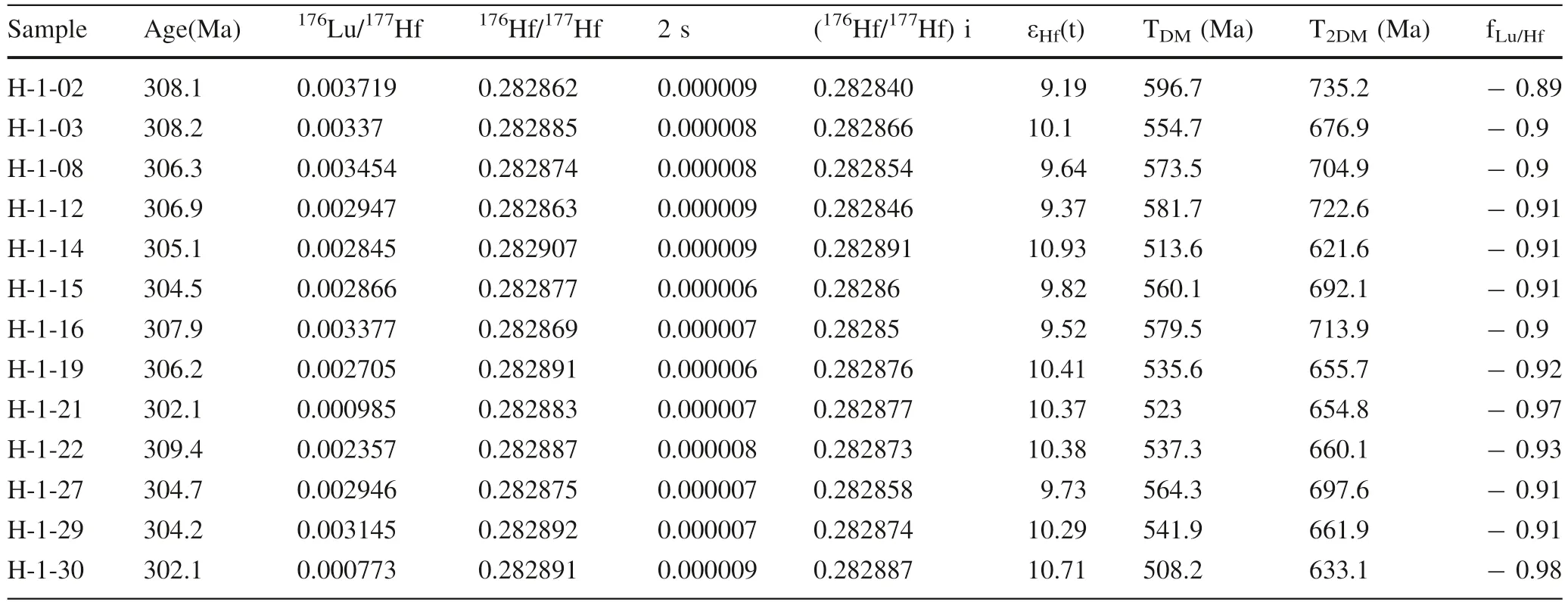
Table 2 Zircon Lu–Hf isotopic data of the granites from the Dunde iron deposit

Fig.5 Major element diagram for the Dunde granites.a K2O versus SiO2 diagram(after Gill 1981)and b ACNK versus ACNK diagram(after Maniar and Piccoli 1989)
All granites have high Rb (198–264 ppm) and low Sr(26–74 ppm) (Table 2),thus with high Rb/Sr ratios(3.59–9.11).They have relatively high LREE and LILE(Rb,Th,U) concentrations (Table 2).In the diagram of chondrite-normalized REE patterns,these granites are characterized by a moderate enrichment in LREE,flat HREEs and remarkable negative Eu anomalies with δEu varying from 0.05 to 0.43 (Fig.6a).Furthermore,it shows enrichments in LILEs and distinct negative Ba,Sr,P,and Ti anomalies in the primitive mantle normalized spidergrams (Fig.6b).

Fig.6 Chondrite-normalized rare earth element diagrams (a) and primitive mantle-normalized trace element diagrams (b) of granite from the Dunde iron ore deposit.Normalized values are after Sun and McDonough (1989)
5.3 Strontium and neodymium isotopes
Five Sr,and Nd isotope analyses were carried out for the Dunde granites (Table 3).These rocks have low Sr concentrations,high Rb/Sr ratios,and variable87Sr/86Sr ratios(0.7201–0.7736),and the initial87Sr/86Sr ratios 0.6585–0.7012 is low.These rocks have143Nd/144Nd ratios(0.512752–0.512768) and147Sm/144Nd ratios(0.1141–0.1432) and show small variations in Nd isotopic compositions with εNd(t) values varying from 4.7 to 5.8 and juvenile two stage Nd model ages(T2DM=601–687 Ma).

Table 3 Major and trace elements of the granites from the Dunde iron deposit

5.4 Zircon Lu–Hf isotopes
Zircon Lu–Hf isotope analyses for the granites are shown in Table 2.Among the concordant zircons,13 were conducted for in-situ Lu–Hf isotopic analysis,176Lu/177Hf ratio for zircon is 0.000773 to 0.003719 and176Hf/177Hf ratio for zircon is 0.282862 to 0.282907.In terms of the zircon age,the initial176Hf/177Hf ratio is 0.282840 to 0.282891.In terms of the zircon εHf(t) value from the sample,the points of this sample exhibit positive values(+9.2 to+10.9,with a mean of+10.0)(Fig.7)with the TDM2=622–735 Ma (with a mean of 679 Ma).
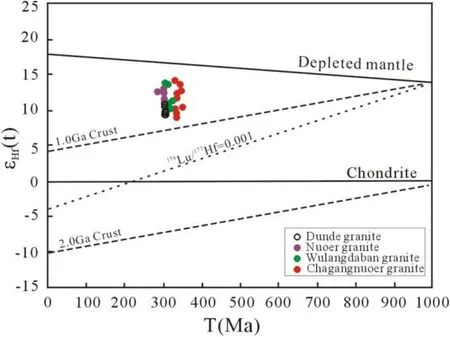
Fig.7 Zircon U–Pb ages versus εHf(t) values for zircons from the Dunde granite (data for Chagangnuoer,Wulangdaban,and Nuoer granite are from Li et al.2006)
6 Discussion
6.1 Genesis classification of the Dunde granites
The Dunde granites have A/CNK varying from 0.94 to 1.08 and belong to weakly peraluminous to weakly metaluminous,different from the typical S-type granites with A/CNK >1.1 (Chappell and White 1974).The Al-enriched minerals have not been observed in the Dunde granites,and the contents of the Corundum-norm for these granites are less than 1%.The P2O5contents of these granites are very low (<0.05%) and decrease with the increase of SiO2(Fig.7a) (Kong et al.2018).These observations suggest that the Dunde granites should not be S-type granite.
Meanwhile,there are no alkaline melanocratic minerals such as arfvedsonite,riebeckite,aegirine,and fayalite(Eby 1990,1992) in the Dunde granites,and they have low 10,000 × Ga/Al values (1.03–1.38,average of 1.16) and low Ce values (51–110 ppm) (Fig.8b),which is distinguishable from A-type granite (Whalen et al.1987,2006).In addition,a graphic-like texture is commonly developed in the Dunde granites,which indicates that quartz and feldspar have simultaneous growth in the granites (Fenn 1986).This structure is the product of the rapid crystallization of the melt under the condition of saturated volatiles (Kirkham and Sinclair 1988).
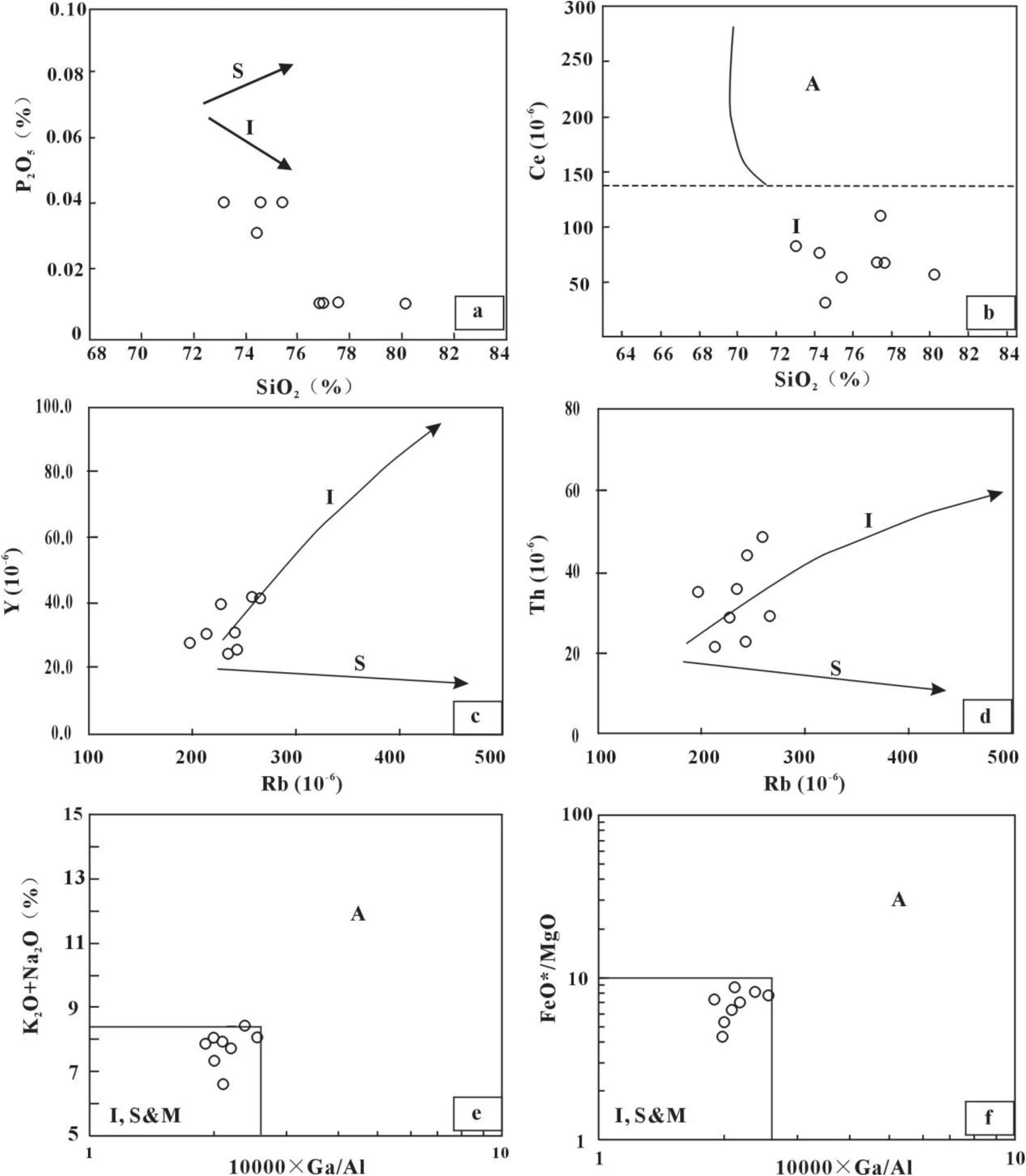
Fig.8 Diagram of rock type discrimination for the Dunde granites.Plot of SiO2 versus P2O5 (a) and Ce (b) Rb versus Y (c) and Th (d);10,000 × Ga/Al versus Na2O+K2O (e) and FeO*/MgO (f)of the Dunde granites (after Whalen et al.1987)
The Dunde granites are characterized by high SiO2(73.41–80.07 wt%,mean of 76.26 wt.%),high Na2-O+K2O (6.63–8.48 wt.%),high differentiation index(D.I.=89.7–95.0,mean of 93.0),and significant negative Eu anomalies and strong depletion of Nb,Sr,P and Ti,similar to those of highly fractionated granites (Clarkede 1981;Wang et al.2014a,b).Therefore,these data confirm that the Dunde granites are highly fractionated I-type granite (Fig.8a–f).The negative anomalies of Eu and Sr are mainly constrained by the fractional crystallization of plagioclase,and depletion of Ba concentration is mainly constrained by orthoclase(Fig.9).The variation of La and(La/Yb)Nis restricted by apatite.
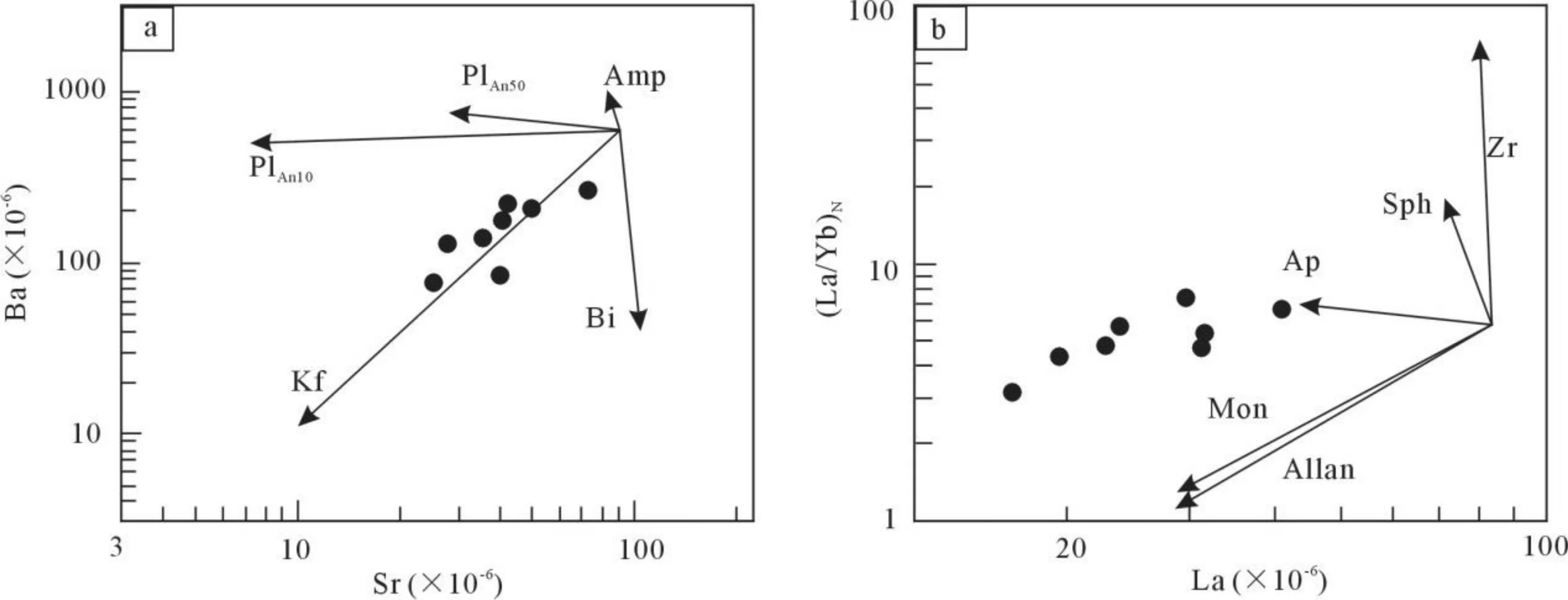
Fig.9 Sr–Ba(a)and La–(La/Yb)N(b)diagrams showing the fractional crystallization trends for the Dunde granites.Partition coefficients of Sr and Ba are from Blundy and Shimizu(1991)for plagioclase,and from Ewart and Griffin(1994)for other minerals.The fractionation trends for accessory minerals are from Wu et al.(2003).PlAn10-plagioclase with An=10;PlAn50-plagioclase with An=50;Kf-K-feldspar;Bi-biotite;Amp-amphibole;Zr-zircon;Sph-sphene;Ap-apatite;Mon-monazite;Allan-allanite
6.2 Petrogenesis of the Dunde granites
The Carboniferous rocks in the Awulale area are mainly intermediate-acid intrusive rocks and volcanic rocks(Wang et al.2019),and there are not a large scale of basaltic rocks.Therefore,these granites in the Awulale Metallogenic Belt (AMB) could not be differentiated from limited basaltic magma (Wyllie et al.1984),and they should be formed by partial melting of crustal materials.
The 306.8 Ma Dunde syenogranite is highly fractionated I-type granite.Whole-rock Nd isotopic and zircon Hf isotopic compositions of the granites are relatively uniform with εNd(t)values varying from 4.7 to 5.8 and εHf(t)values ranging from+9.2 to+10.9.According to the crustal Nd-Hf isotope correlation array (Vervoort and Blichert 1999),the Hf isotopic compositions of this granite are coupled with the Nd isotopic compositions.Therefore,these isotopic compositions indicate that the magma source of granites may be a depleted mantle nature or a juvenile lower crust.While,the average Ce/Pb and Nb/Ta ratios of the Dunde granites were 10.37 and 10.02,respectively,which was close to that of crustal values (Ce/Pb <15,Furman et al.2004;Nb/Ta=12–13,Barth et al.2000),far from that of mantle-derived magma value (Ce/Pb=25 ±5,Furman et al.2004;Nb/Ta=17.5 ± 2.0,Green 1995),indicating that the magma source of granites should be mainly juvenile crustal material.The Nd and Hf model ages (T2DM) are 601–687 Ma and 622–735 Ma,respectively,which indicates that the differentiation for crustal and mantle can be traced back to Neoproterozoic,These characteristics indicate that that the magma source of granites in the Dunde mining area could be the juvenile lower crust rather than the ancient crust.
According to the markedly negative Sr,Ba,and Eu anomalies in the Dunde syenogranite,it is speculated that the source area has a residual Ca-rich plagioclase phase,indicating that the granite has a relatively low diagenetic pressure (less than 0.8 or 1.0 GPa).The normative quartzalbite-orthoclase (Q–Ab–Or) pseudo-ternary (Tuttle and Bowen 1958;Gualda and Ghiorso 2013),which is used to estimate the equilibration pressure for granitic systems,indicates an equilibration pressure of approximately 50–200 MPa for the Dunde syenogranite,similarly with Beizhan syenogranite,while lower than Chagangruoer granodiorite and Nuoer alkali feldspar granite (Fig.10).Thus,the Dunde syenogranite must be emplaced at shallower levels of the juvenile lower crust.
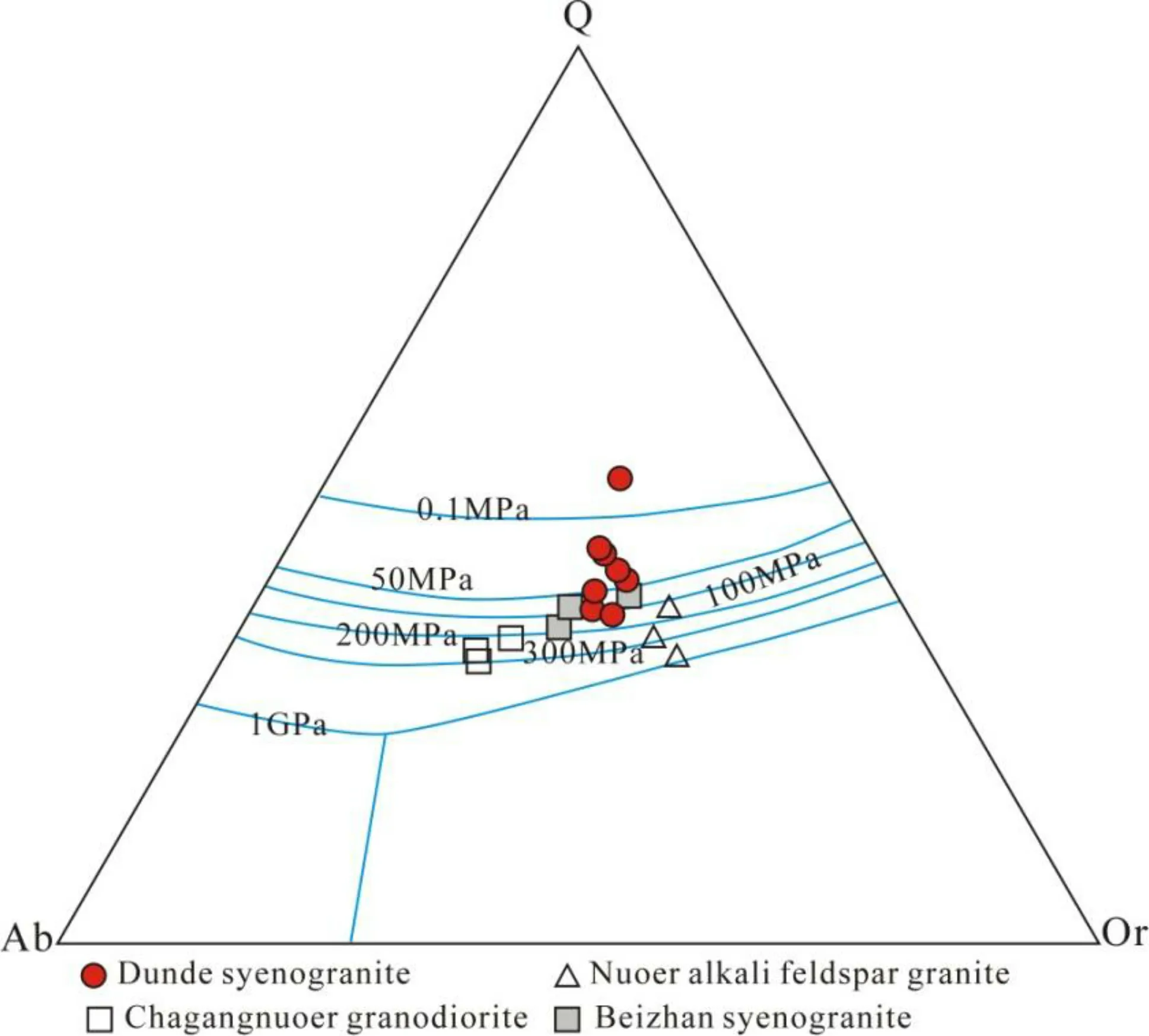
Fig.10 Q-Ab-Or diagram for the granites (after Huang and Wyllie 1975)
6.3 Tectonic setting and mineralogenetic epoch for the Dunde iron deposit
The geochronology and geochemistry studies of Carboniferous volcanic rocks in the Western Tianshan (Zhu et al.2009;Zhang et al.2012;Wang et al.2017,2019)and eclogite from the Chinese South Tianshan indicate that the amalgamation among the Yili blocks and the Junggar terrane is believed to have ceased before 316 Ma (Su et al.2010;Han et al.2010).Late Carboniferous granitoid intrusions around 300 Ma are usually sparse and small,such as Baidexiqiaoke,Zhongyangchangdaoban,Zeketaibei,Nuoerxibei and Wulangdaban intrusions (Li 2013),which is distinctly different from widely distributed Carboniferous arc-related volcanic rocks in the Western Tianshan (Chen et al.2013;Ma et al.2015;Zhang et al.2016;Zhao et al.2018;Du et al.2018).The intrusive rock assemblage formed in this period is gabbro diorite,granitic porphyry,granite-alkali feldspar granite.The magmatism is characterized by middle-K calc-alkaline series,high-K calc-alkaline series and potassium basaltic series,and A-type granite appears in the late stage (Li 2013).The 306.8 Ma Dunde syenogranite is high-K calc-alkaline series,and has moderate enrichment in LREE and LILEs and distinct negative Ba,Sr,Eu,P,and Ti anomalies,with mild negative Na-Ta anomalies.In the discriminant diagrams of the tectonic environment the Dunde syenogranite plot in the field of volcanic arc+syncollisional granites in the Nb-Y diagram,and in the volcanic arc granites and postcollisional granites (Fig.11).The Yishijilike Formation in the Late Carboniferous is marked by bimodal volcanic rocks,and the Dongtujinhe formation is residual Marine clastic sedimentary in the Late Carboniferous,while the Keguqinshan formation is mainly continental coarse clastic rock.These characteristics indicate the Awulale metallogenic belt experienced a tectonic transformation in the late Carboniferous (Li et al.2007;Li 2013).Therefore,it is concluded that the 306.8 Ma Dunde syenogranite in the Awulale area was formed in a post-collision extensional tectonic setting.
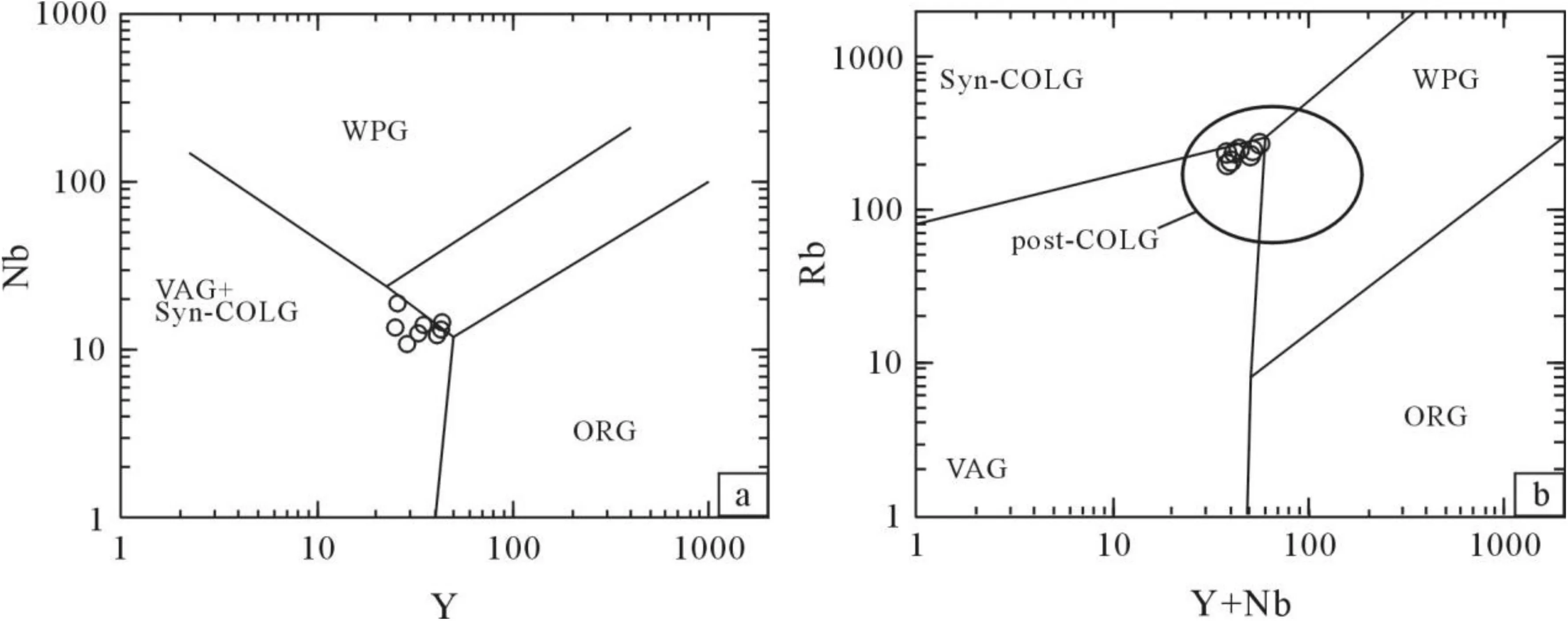
Fig.11 Discrimination diagrams for settings of the granties (after Pearce et al.1984). VAG volcanic arc granites, Syn-COLG syncollisional granites, post-COLG post collisional granites, ORG ocean ridge granite, WPG within plate granite
The ore bodies of the Dunde deposit are hosted in basaltic tuff and purplish-red andesite of the Late Carboniferous Dahalajunshan Formation.Recent zircon U–Pb ages for the volcanic rocks in the deposit are in the range of 316– 320.6 Ma (Duan et al.2014;Jing 2016),which is similar to the age of the volcanics in the AMB(Feng et al.2010;Jing 2016;Zhang et al.2012),indicating the main iron mineralization age.Different from other deposits in the AMB,the Dunde deposit contains 1,286,100 tons of zinc metals and 28.91 tons of gold (Ding 2017),and the zinc-gold mineralization mainly occurred in the hydrothermal metallogenic stage,and the Re-Os age of pyrite associated with the zinc mineralization is 301.2 ± 2.4 Ma (Kang 2018).So,the here 306.8 ± 1.0 Ma granites intruded the volcanics have no alteration in the deposit,which is in accordance with the Re–Os age of pyrite associated with the zinc mineralization(Li et al.2022),indicating that the time of the zinc-gold mineralization could be from 320 to 306.8 Ma and later than the main epoch of iron mineralization.Based on the 306.8 Ma granites are not contacted with limestone and are far from the area where ore bodies and mineralized altered rocks are widely developed,which is different from the skarn-type deposit.This epoch granites intruding the volcanics may have provided heat for the early volcanic rocks,activating the metals such as zinc and gold in the volcanic rocks to mineralization.
7 Conclusions
In this study,zircon U–Pb dating shows the granite from the Dunde iron-zinc polymetallic mining area was crystallized at 306.8 ± 1.0 Ma.The data presented here in combination with geochronology of the volcanic rocks in the mining area could constrain the metallogenic age from 320 to 306.8 Ma.The Dunde granites are of highly fractionated I-type granites in a post-collision extensional tectonic setting and they could be derived from the juvenile lower crust.This epoch granites may have provided heat for the early volcanic rocks,activating the metals such as zinc and gold in the volcanic rocks to mineralization.
AcknowledgementsThis work is supported by Special Fund for Basic Scientific Research of Central Colleges,Chang’an University(Grant No.: 300102279210),the Natural Science Foundation of Shaanxi Province (Grant No.: 2019JQ-690),and the geological and mineral survey evaluation project of China Geological Survey(Grant No.: DD20190065).We are grateful to Mr.Chen Jianzhong of the Three Geological Team of the Xinjiang Bureau of Geology and Mineral Resources for the assistance in the field.
Author contributionsZX conceived of the presented idea.ZX and HD conduct field research.ZX,HD and YR discussed the results of the experiments and wrote the manuscript.
Declarations
Conflict of interestThe authors declare no conflicts of interest.
- Acta Geochimica的其它文章
- Carbon dioxide partial pressure and its diffusion flux in karst surface aquatic ecosystems: a review
- High-precision double-spike Cd isotopic measurements of seawater by MC-ICP-MS and its application to seawater affected by hydrothermal vent fluids
- Geochronology and geological significance of the strata of the Neoproterozoic Nanhua System,SW North China Craton
- Re–Os and Pb isotope features of pyrite in the Shihangli graphite deposit: implications of coal-generated graphite mineralization in central Hunan,South China
- In situ infiltration-precipitation processes in some rock systems
- Isotopic analysis based on terahertz spectrum

